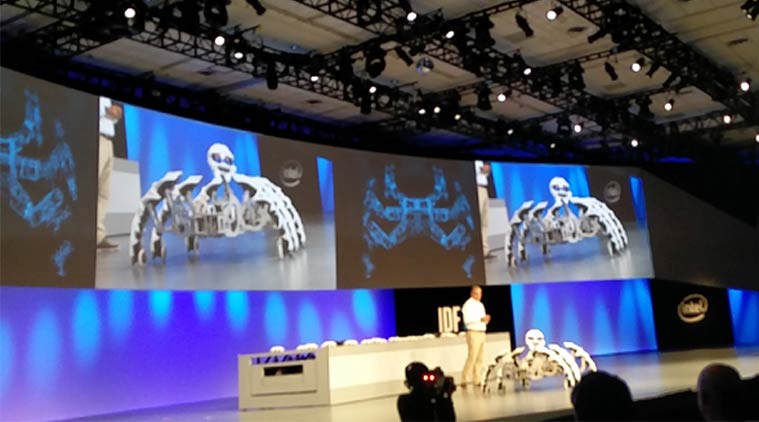 Intel CEO Brian Krzanich, at the IDF15 in San Francisco on August 18. (Express Photo by: Nandagopal Rajan)
Intel CEO Brian Krzanich, at the IDF15 in San Francisco on August 18. (Express Photo by: Nandagopal Rajan)
If what silicon giant Intel showcased at its developer conference is any indicator, then our future is going to be a hard-to-separate mix of the real and the virtual. “Never before have we seen such diversity in opportunity for developers to bring more disruptive products to the market,” is how Intel CEO Brian Krzanich referred to the impact of this new intersection while delivering his keynote at the Intel Developer Conference in san Francisco.
And there was a lot of this new world on show at the keynote itself, from robotic spiders that danced to the gestures of Krzanich to the first glimpse of Google’s Project Tango smartphones powered by Intel RealSense technology and a virtual butler called Relay that could make its way across hotel alleyways using the same technology.

And this hard to avoid inflexion point of worlds has prompted Intel to think differently, so much so that it has three new assumptions for its future endeavours.
 Gesture controlled robotic spiders. (Express Photo by: Nandagopal Rajan)
Gesture controlled robotic spiders. (Express Photo by: Nandagopal Rajan)
Firstly, it is banking on sensification of compute where sight, sound and touch become integral to everything, but in a more natural, more human, kind of way. Thanks to technologies like Intel Smart Sound, Cortana will wake up even if the PC is powered down and RealSense’s ability to bring the power of human sight to a computing device will mean that the Relay Robot from Savioke will be able to find its way around a hotel alleyway without bumping into guests.
Secondly, smart and connected would mean everything has the ability to bank upon a larger repository of knowledge. For instance, Intel showcased the Memomi memory mirror which is already set up in a handful of retail outlets in the US telling customers how they would look in an apparel they have not yet tried.
 Intel is partnering with google for better audio technologies. (Express Photo by: Nandagopal Rajan)
Intel is partnering with google for better audio technologies. (Express Photo by: Nandagopal Rajan)
Then Intel believes everything will end up being an extension of you, but beyond what we would imagine a regular wearable would be. So even as Intel Curie powered wearables will start infiltrating the ever growing segment in the coming quarters, there will be unique new use cases like the BMX Bike with the module embedded telling a computer what which can tell a computer which tricks it is performing. “Imagine how sports will change when it is digitized,” says Krzanich. And there is also the new possibility of using wearables to secure the workplace.
Most of technologies, as Krzanich reiterated, were being demoed real time or already had limited rollouts in some markets. For a change we were not speaking about technologies that were years away, but stuff on which the developers could start working right away using the SDKs that were already on offer or had just been announced. Yes, there has never been a better time to be a developer.
Story continues below this ad
Disclaimer: The journalist is attending the IDF conference in San Francisco on the invitation of Intel Corporation

 Intel CEO Brian Krzanich, at the IDF15 in San Francisco on August 18. (Express Photo by: Nandagopal Rajan)
Intel CEO Brian Krzanich, at the IDF15 in San Francisco on August 18. (Express Photo by: Nandagopal Rajan)
 Gesture controlled robotic spiders. (Express Photo by: Nandagopal Rajan)
Gesture controlled robotic spiders. (Express Photo by: Nandagopal Rajan) Intel is partnering with google for better audio technologies. (Express Photo by: Nandagopal Rajan)
Intel is partnering with google for better audio technologies. (Express Photo by: Nandagopal Rajan)





